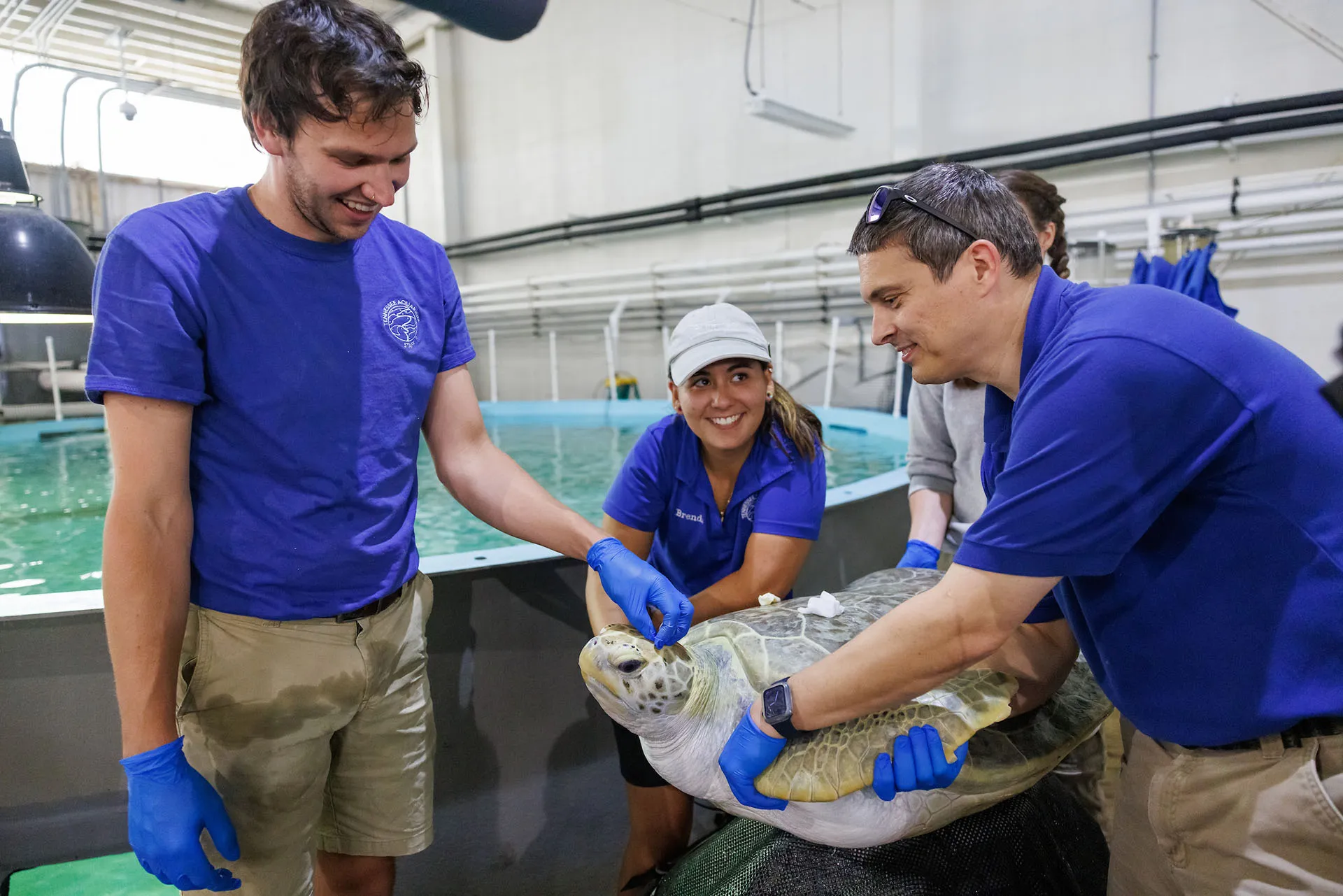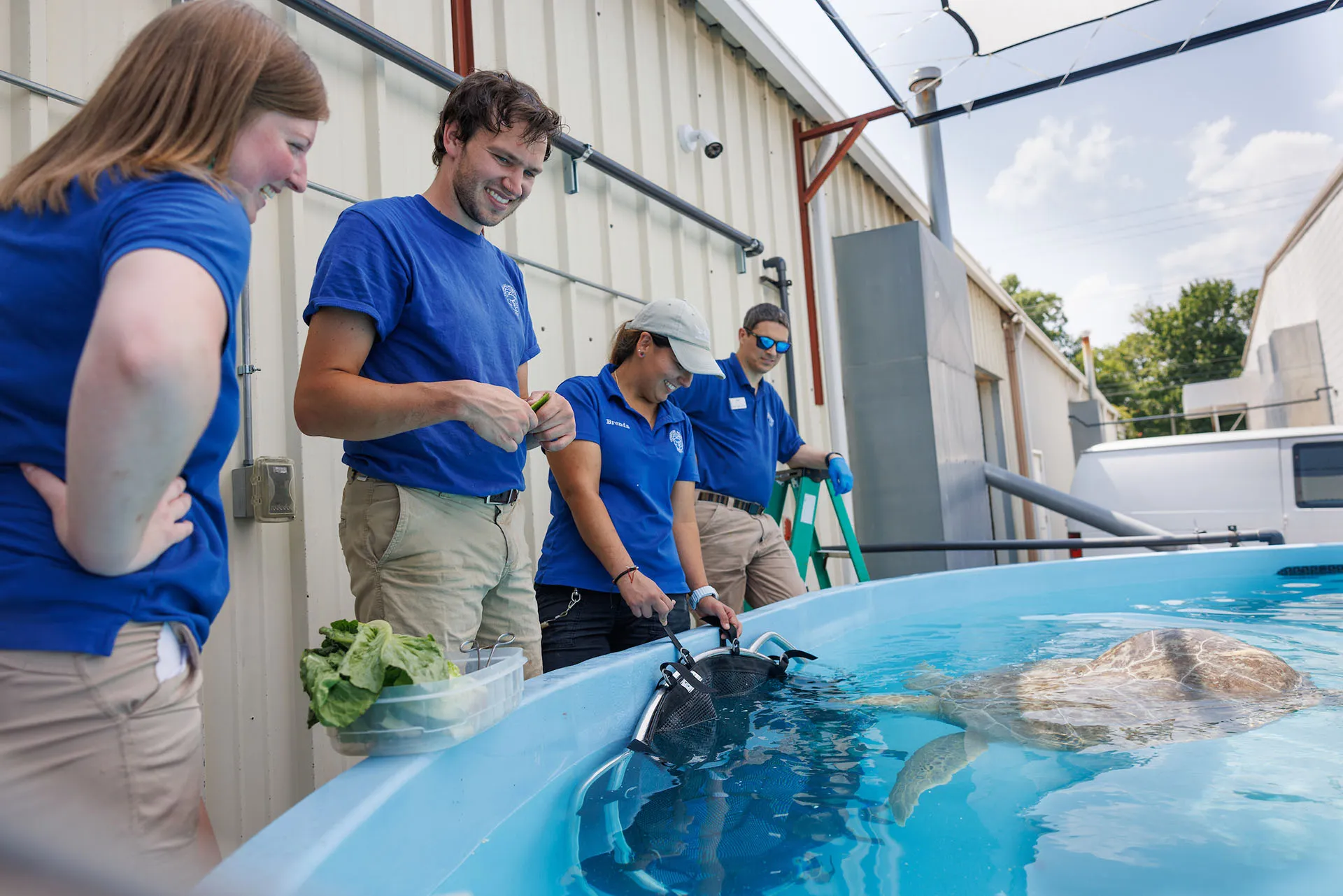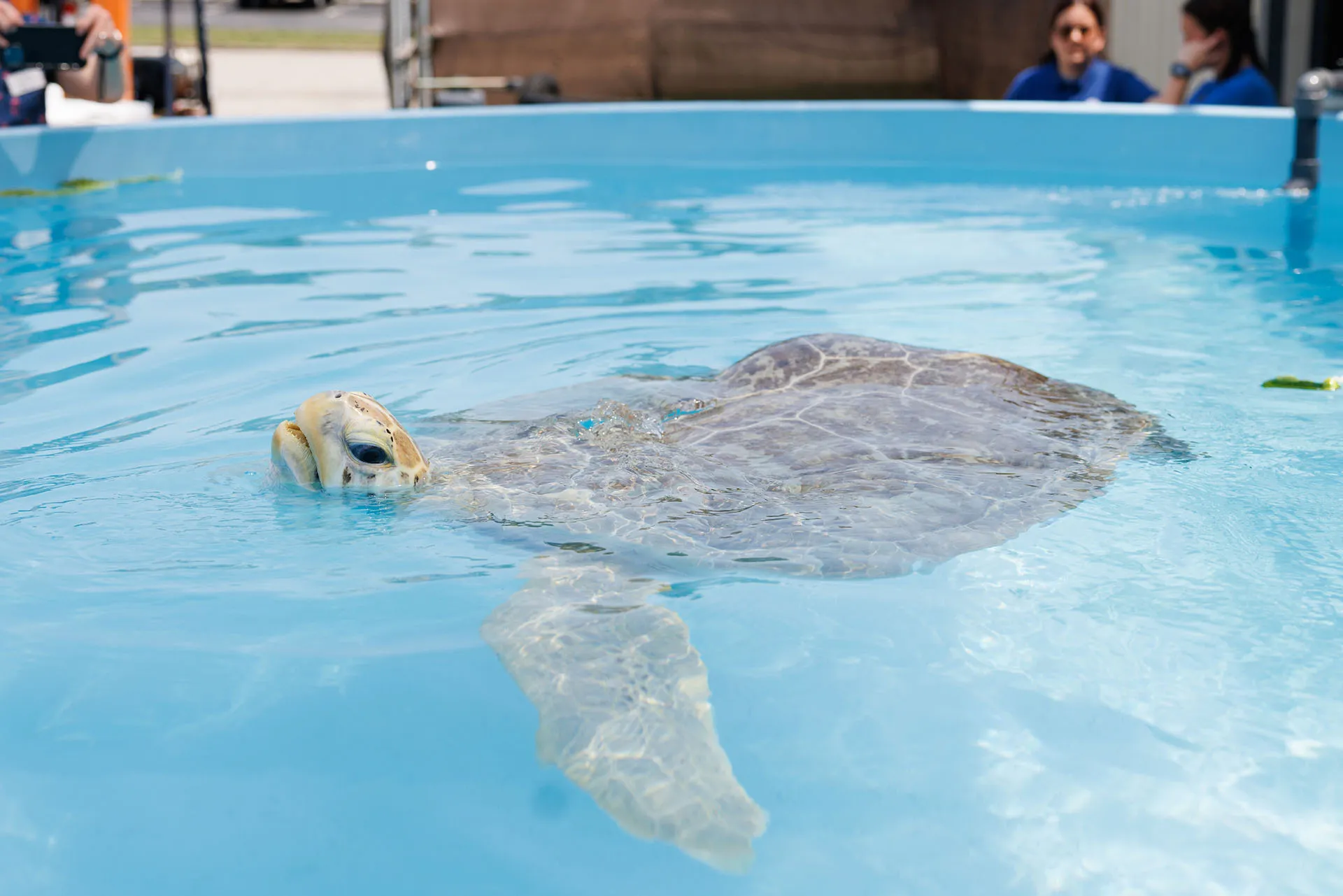After more than three years of hoping, planning, and building, we recently completed a home improvement project for one of the Aquarium’s most beloved residents.
Green Sea Turtle Oscar – the “little turtle that could” whose story began in 2003 with a heroic rescue by fishermen after a boat strike off the coast of Florida – finally got to swim beneath the warm rays of the sun in a brand-new outdoor habitat at the Aquarium’s off-site Animal Care Facility.
Located away from the Aquarium’s public buildings, the Animal Care Facility offers space to hold new arrivals to the Aquarium to ensure they are healthy before introduction to the Aquarium’s viewable exhibits. It’s also a location for ministering to ill or recovering animals and — as in Oscar’s case —long-term housing for animals that are unable to be on exhibit. Though they may not be in public view, the facility’s residents receive plenty of attention from staff, and the same exemplary care provided to residents in the River Journey and Ocean Journey buildings.
For more than four years, Oscar has lived in a massive indoor habitat at the Animal Care Facility which aquarists and veterinary staff manage. This new outdoor living space is an upgrade that will provide numerous benefits to his well-being.
“He’s got his giant tank inside where he’s been and does great,” says Aquarium VP, Chief Husbandry & Exhibits Officer Thom Demas. “But now, he’s got a little summer retreat outside where he can get a little bit of fresh air, see the natural sunlight, and experience that open ocean feel a little bit.”


Sunlight is an important aspect of caring for animals in the Aquarium’s charge, like Oscar, says Veterinarian Dr. Chris Keller. The ultraviolet light provided by the sun helps them metabolize nutrients like vitamin D and calcium, create bone, develop their shells, and strengthen their immune system.
“Sunlight, specifically, is anti-fungal and anti-bacterial,” Keller says. “That ultraviolet radiation is a really important part of keeping animals healthy.”
Oscar received many of these benefits from a “sun” (artificial ultraviolet lighting installed over his indoor habitat) during his stay inside the Animal Care Facility. As anyone who’s ever visited the beach can attest, though, it’s hard to beat basking in the real deal.
“We expect him to be healthier, happier, maybe get a little bit of a nice tan, so that he looks even more like a normal Green Sea Turtle that’s outside in the ocean,” Keller says.
The new climate-controlled pool is the culmination of years of effort by the Aquarium’s veterinary, husbandry, facilities, and life support/operations teams. Seeing this project to completion couldn’t have happened without the generous support of a long-time volunteer and philanthropist who took a special interest in Oscar’s unique situation.
Reaching this point in Oscar’s lengthy story was no easy feat. After his rescue, he was taken to Florida’s Marine Science Center, where caregivers worked tirelessly to address the significant injuries caused by his boat strike. His rear flippers were mangled, his shell was deeply gouged by the propeller and the repairs to address the damage left him with a pocket of air inside his shell. This surplus of air resulted in positive buoyancy syndrome, also known as “bubble butt syndrome,” which causes the rear end of Oscar’s shell to rise above his head, making it difficult to swim or dive.
Due to his injuries and with no prospect for survival in the wild, Oscar was considered non-releasable. It was up to human caregivers to offer him a home. He arrived at the Aquarium in 2005 and was introduced to what was then the Gulf of Mexico exhibit in the River Journey building. There, his charisma and unflappable attitude immediately captured the attention and adoration of guests.
After the Aquarium’s Ocean Journey building opened later that year, Oscar eventually moved to the 618,000-gallon Secret Reef exhibit. In 2019, the Aquarium’s other larger Green Sea Turtle, Stewy, began to cause problems for Oscar, whose limited mobility prevented him from diving to escape his neighbor.
“He reached a point in the Secret Reef exhibit that he and the other male sea turtle didn’t get along, so we had to remove him from the exhibit,” Demas says.


To help address Oscar’s mobility problems, the Aquarium pursued diagnostic tools, including traveling for a CT scan at an area hospital. He also underwent exploratory diagnostic surgery conducted by Dr. Shane Boylan, a sea turtle specialist who drove more than 400 miles to Chattanooga from the South Carolina Aquarium in Charleston.
In the years since, Oscar has lived at the Animal Care facility, where his health has improved significantly. Unfortunately, he will likely not be able to return to the Secret Reef any time soon, which means the animal care team needed to ensure they could offer him the best environment possible in his new home.
Oscar will spend the warm summer months lounging in his new outdoor pool, soaking up the sun like he would if he were still cruising the open ocean.
“Green Sea Turtles, although they don’t necessarily bask, they frequently spend time in the warm oceans close to the surface,” Keller says.
When cold weather arrives, he will return to his climate-controlled indoor home until conditions are once more favorable for him to soak up the sun outside.
To make sure Oscar doesn’t get too much sun, a shade cloth was installed that blocks about 50% of the light transmission, helping him avoid over-exposure and a turtle-y uncomfortable sunburn.
Oscar took to his new summer home almost instantly, cruising the waters and munching on snacks of bell peppers, apples, and romaine lettuce.
Though he wants Oscar to be where people can see him, Demas recognizes that’s a difficult prospect when considering what’s best for the plucky turtle. It’s hard to find another facility willing to provide long-term care for an animal that was a boat-strike victim. This move, then, is the Aquarium fulfilling its duty to give Oscar (and all its residents) the best possible life, even if they’re not where guests can see and appreciate them.
“Just because Oscar isn’t perfect, and just because Oscar can’t be on exhibit right now doesn’t mean he deserves any less than any other animal we care for,” Demas says.
